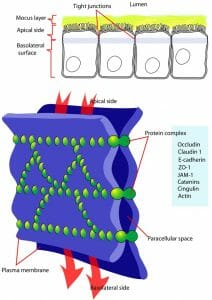Tight Junctions Definition
Tight junctions are areas where the membranes of two adjacent cells join together to form a barrier. The cell membranes are connected by strands of transmembrane proteins such as claudins and occludins. Tight junctions bind cells together, prevent molecules from passing in between the cells, and also help to maintain the polarity of cells. They are only found in vertebrates, animals with a backbone and skeleton; invertebrates have septate junctions instead.
Function of Tight Junctions
Tight junctions have several different functions. Their most important functions are to help cells form a barrier that prevents molecules from getting through, and to stop proteins in the cell membrane from moving around. Tight junctions are often found at epithelial cells, which are cells that line the surface of the body and line body cavities. Not only do epithelial cells separate the body from the surrounding environment, they also separate surfaces within the body. Therefore, it is very important that the permeability of molecules through layers of epithelial cells is tightly controlled.
If molecules are blocked by tight junctions and physically unable to pass through the space in between cells, they must enter through other methods that involve entering the cells themselves. They could pass through special proteins in the cell membrane, or be engulfed by the cell through endocytosis. Using these methods, the cell has greater control over what materials it takes in and allows to pass through. However, in endothelial cells, certain proteins must be kept on certain sides of the cell. The apical, or outside layer, of the sheet of cells contains proteins that only let certain substances pass through. The basal, or inside layer, is where cells let molecules pass through them by expelling them from their membrane in a process called exocytosis. Exocytosis also relies on specific proteins in order to work correctly. Tight junctions keep the correct proteins on the correct sides of the cell in order for these functions to occur. This also helps maintain the polarity of cells.
Another function of tight junctions is simply to hold cells together. The branching protein strands of tight junctions link adjacent cells together tightly so that they form a sheet. These strands are anchored to microfilaments, part of the cell’s cytoskeleton that is made up of long strands of actin proteins. Microfilaments are located inside the cell, so the combination of microfilaments and sealing strands anchors the cells together from the inside and the outside.
Structure of Tight Junctions

This diagram depicts a tight junction between cells and also provides examples of proteins found in the junction.
Tight junctions are a branching network of protein strands on the surface of a cell that link with each other throughout the surface of the membrane. The strands are formed by transmembrane proteins on the surfaces of the cell membranes that are adjacent to each other.
There are around 40 different proteins at tight junctions. These proteins can be grouped into four main types. Transmembrane proteins are wedged in the middle of the cell membrane and are responsible for adhesion and permeability. Scaffolding proteins organize transmembrane proteins. Signaling proteins are responsible for forming the tight junction and regulating the barrier. Regulation proteins regulate what proteins are brought to the cell membrane in vesicles.
Claudins and occludins are the two main types of proteins present at tight junctions, and they are both transmembrane proteins. Claudins are important in forming tight junctions, while occludins play more of a role in keeping the tight junction stable and maintaining the barrier between cells that keeps unwanted molecules out.
Other Cell Junctions
Tight junctions are one of three main types of junctions in vertebrate cells. The other two types are gap junctions and anchoring junctions. Gap junctions, also known as communicating junctions, are channels in cells that let adjacent cells communicate with one another without having to send molecules through the extracellular fluid surrounding the cell. Connexin proteins form the channel, which has a central pore called a connexon that molecules can pass through. Anchoring junctions hold cells together with anchoring proteins such as catenins and cadherins. The cell’s cytoskeleton is tethered to proteins that link adjacent cells.
Related Biology Terms
- Anchoring junction – A type of cell junction in which cells are connected by a mass of proteins.
- Gap junction – A type of cell junction that allows adjacent cells to exchange molecules.
- Cytoskeleton – A network of protein filaments that extends throughout the cell.
- Epithelial cells – Cells that line the interior surfaces of organs and are also found on the surface of the body.
Quiz
1. Which animal does not have tight junctions in between any of its cells?
A. Cat
B. Squid
C. Bird
D. All animals have tight junctions between some of their cells.
2. Why is it important for tight junctions to keep all cell membrane proteins in place?
A. Different processes occur on the apical and basal sides.
B. It maintains polarity.
C. If the proteins move, they may let in different molecules.
D. Both A and B
3. What is the role of scaffolding proteins?
A. To form the tight junction
B. To regulate the proteins that are brought to the cell membrane
C. To maintain adhesion and permeability
D. To organize transmembrane proteins
